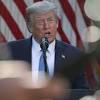Fed Raises Rates to Try to Tame Inflation: Live Economy News Updates


Federal funds target rate
0.5-point
increase

Federal funds
target rate
0.5-point
increase

Federal funds target rate
0.5-point
increase

Federal funds
target rate
0.5-point
increase

Federal funds
target rate
0.5-point
increase
The Federal Reserve ramped up its attack on rapid inflation on Wednesday, approving its biggest interest rate increase since 2000, detailing a plan to shrink its massive bond holdings, and signaling that it will continue working to cool the economy as it tries to tamp down the fastest price increases in four decades.
Yet investors found a reason for relief. While the Fed raised interest rates by half a percentage point and Chair Jerome H. Powell said that similarly large increases would be “on the table” at the Fed’s upcoming meetings, he shot down the idea that policymakers were considering an even larger move, as some investors had feared.
That reassurance helped to send stock indexes soaring. The S&P 500 rose 3 percent, the biggest jump since May 2020.
Many on Wall Street have been nervously eyeing the Fed’s path as it tries to beat back inflation, worried that officials might slow demand so much that the economy will tip into a painful recession. While the Fed is withdrawing monetary help at the fastest pace in decades, Mr. Powell’s comments showed that the central bank is trying to chart a brisk course, but not a drastic one.
“Markets took it as: The Fed is not overdoing it,” said Priya Misra, head of global rates strategy at T.D. Securities.
Still, the Fed’s suite of policy changes underscored that the central bank is serious about cooling down the economy and the job market. Officials have grown increasingly nervous that price increases, which have lasted longer than many economists had expected, could become more permanent. By lifting rates and shrinking its nearly $9 trillion in bond holdings, the Fed will push borrowing costs higher across the economy, moves aimed at slowing demand.
“Inflation is much too high and we understand the hardship it is causing, and we’re moving expeditiously to bring it back down,” Mr. Powell said during a news conference on Wednesday. “We have both the tools we need and the resolve it will take to restore price stability.”
Policymakers spent most of 2021 hoping that inflation would ease on its own as supply shortages moderated and as the economy evened out following early-pandemic disruptions. But normalcy has yet to return, and inflation has only accelerated. Now, fresh pandemic-related lockdowns in China and the war in Ukraine are further elevating prices for goods, food and fuel. At the same time, workers are in short supply and wages are rising rapidly in the United States, feeding into higher prices for services as consumer demand remains strong.
Mr. Powell noted that developments in China and Ukraine could have significant repercussions for inflation.
“They’re both capable of preventing further progress in supply chains healing, or even making supply chains temporarily worse,” Mr. Powell said. While he noted that the Fed’s tools work on demand, not supply, he said “there’s a job to do on demand.”
Fed officials have decided that they no longer have the luxury of waiting for inflation to moderate on its own. Prices climbed 6.6 percent in the year through March, according to the Fed’s preferred measure of inflation, more than three times the 2 percent average annual increases that the Fed aims for.
Officials began to raise interest rates in March and have recently signaled that they will lift borrowing costs up to the point where they begin to constrain the economy. Mr. Powell said that once they achieve that goal, officials will assess how the economy is performing and continue to raise rates if doing so is necessary.
“We need to do everything we can to restore stable prices,” he said. “Everyone will be better off if we can get this job done — the sooner the better.”
Still, Mr. Powell indicated that, at least for now, the Fed is trying to contain prices in a way that does not tank the economy. Some Fed officials had signaled that a 0.75 percentage point move could be possible — but Mr. Powell said on Wednesday that such a big increase is “not something the committee is actively considering.”
That comment helped to soothe investors, who have spent weeks worrying that the Fed might decide to overcorrect after moving too slowly away from policies aimed at stoking growth.
“The market was really spooked” about the potential for a three-quarter-point hike, Ms. Misra at T.D. said. “Chair Powell tried to market this as a soft-ish landing hike, and he succeeded.”
Deciding how quickly to remove policy support is a fraught exercise. Central bankers are hoping to move decisively enough to arrest the pop in prices without curbing growth so aggressively that they tip the economy into a deep downturn.
Mr. Powell nodded to that balancing act, saying “I do expect that this will be very challenging — it’s not going to be easy.” But he said the economy has a good chance “to have a soft, or soft-ish, landing.”
He later elaborated that it could be possible to “restore price stability without a recession, without a severe downturn, and without materially higher unemployment.”
The balance sheet plan the Fed released on Wednesday matched what analysts had expected, which probably also contributed to the sense of market calm. The Fed will begin shrinking its nearly $9 trillion in asset holdings starting in June by allowing Treasury and mortgage-backed debt to mature without reinvestment. It will ultimately let up to $60 billion in Treasury debt expire each month, along with $35 billion in mortgage-backed debt, and the plan will have phased in fully as of September.
By reducing its bond holdings, the Fed is likely to take steam out of financial markets — bond prices will fall, causing yields to rise, and riskier investments like stocks will become less attractive. It also could help to cool the housing market by pushing up longer-term borrowing costs, which follow bond yields, reinforcing the effect of the central bank’s interest rate increases.
In fact, mortgage rates have already begun to push higher, climbing nearly two percentage points since the start of the year. The rate on a 30-year fixed-rate mortgage averaged 5.1 percent for the week that ended April 28, according to Freddie Mac, touching its highest level in more than a decade.
The Fed’s moves “will quickly make financing big-ticket purchases more challenging.” Jonathan Smoke, chief economist at Cox Automotive, wrote in a research note following the meeting. “This is exactly what the Fed wants to see. As demand for homes, cars and other durables declines in response to declining affordability, the rate of price increases should slow as well.”
That inflation slowdown would come as less shopping and higher financing costs translate into slower business expansions. As companies hire less and as demand for workers wanes, wage growth will slow down, further slowing demand and helping to weigh down prices.
“You can see that the labor market is out of balance: You can see that there is a labor shortage,” Mr. Powell said. “We’ve got to get back to price stability so that we can have a labor market where people’s wages aren’t being eaten up by inflation, and where we can have a long expansion, too.”


 United States
United States Argentina
Argentina  Australia
Australia  Austria
Austria  Brazil
Brazil  Canada
Canada  Chile
Chile  Czechia
Czechia  France
France  Germany
Germany  Greece
Greece  Italy
Italy  Mexico
Mexico  New Zealand
New Zealand  Nigeria
Nigeria  Norway
Norway  Poland
Poland  Portugal
Portugal  Sweden
Sweden  Switzerland
Switzerland  United Kingdom
United Kingdom 





























